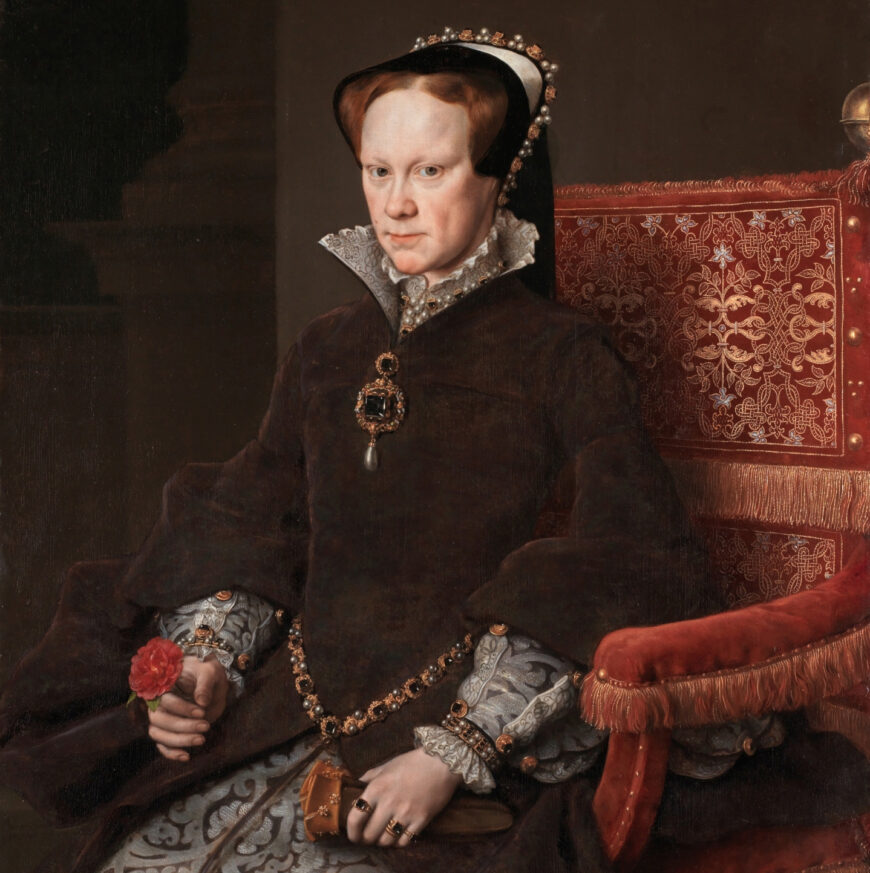
Mary Tudor (detail), Anthonis Mor, Portrait of Mary Tudor, 1554, oil on panel, 178 x 136.5 cm (Museo Nacional del Prado, Madrid)
A regal presence. An iron will. A hint of impatience. A suggestion of a smile. These are some of the traits that one can discern in the countenance of Mary I, more commonly known as Mary Tudor, Catholic queen of England and Ireland, who reigned from 1553 to 1558. This acutely observed and beautifully understated portrait was painted by the Netherlandish artist Anthonis Mor (also known as Antonio Moro), who worked as court painter to the Habsburg dynasty.
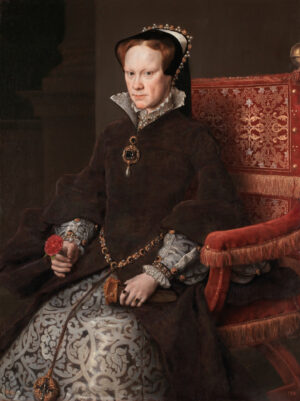
Anthonis Mor, Portrait of Mary Tudor, 1554, oil on panel, 178 x 136.5 cm (Museo Nacional del Prado, Madrid)
Queen Regnant
Due to her own royal lineage, Mary was the first woman to rule as monarch in England and Ireland as “Queen Regnant”: she did not become monarch through marriage, but ruled in her own right—and on her own terms. [1]
The portrait, painted from life, was commissioned by Charles V, Holy Roman Emperor, to commemorate the marriage of Mary to Charles V’s son, Prince Philip, who ruled as Philip II, king of Spain, from 1556 until 1598, with whom Mary ruled England and Ireland jointly from 1554 until her death in 1558, and with whom she hoped to have an heir. Mary, however, who endured ill health throughout her life, suffered “phantom” or false pregnancies (known as pseudocyesis) and two miscarriages.
Henry VIII, king of England and Mary Tudor’s father, had broken with the Catholic Church of Rome in 1534 and had created the Protestant Church of England through the Act of Supremacy, which had made the English monarch head of the Church of England. In her courage, in her brutal impatience, Mary was very much her father’s daughter. Notoriously, Henry VIII had two of his six wives tried and executed for adultery and treason (Anne Boleyn and Katherine Howard). A pious and uncompromising Catholic, Mary’s overarching ambition was to re-establish papal supremacy in her kingdoms and—far more difficult—to reconvert the hearts and minds of the English people to the Catholic Church.
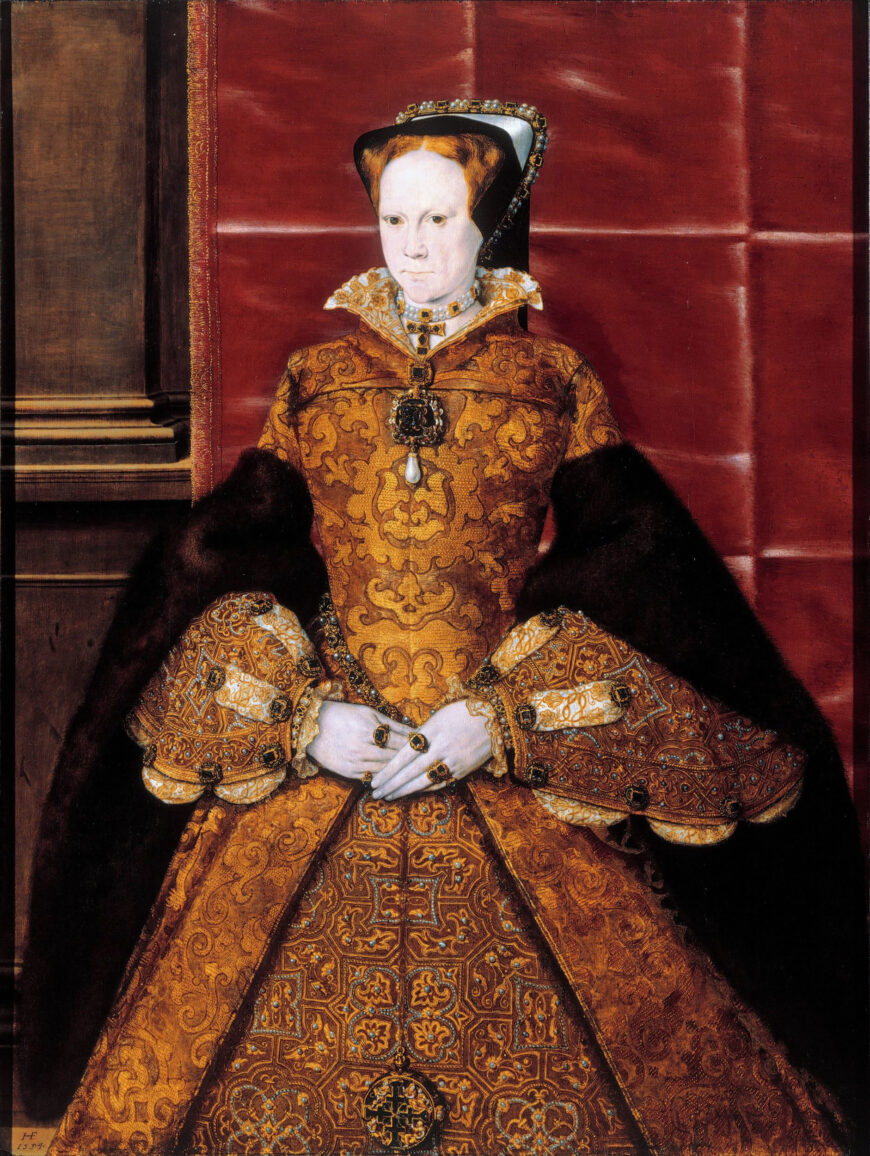
Hans Eworth, Mary Tudor, 1554, oil on panel, 107 x 81 cm (The London Society of Antiquities, London)
Enthroned in crimson velvet
Mor’s painting is uncharacteristic of royal portraits produced at the English royal court, which usually depicted monarchs in three-quarter length, in a standing position, as, for example, in Hans Eworth’s 1554 portrait of Mary Tudor. Instead, in Mor’s portrait Mary is depicted in three-quarter profile, seated in an exquisitely embroidered crimson velvet chair, a symbol of authority. She is wearing a beautifully embroidered dress with a foliate pattern and a purple overgarment. Pearls and precious stones adorn her headdress, cuffs, and belt. The seated portrayal recalls (though is not directly modeled on) Raphael’s portrait of Pope Julius II, in which Julius is also sitting in a red velvet chair. Mor’s painting also refers to the same compositional formula of Raphael and Giulio Romano’s portrait of Doña Isabel de Requesens y Enríquez de Cardona-Anglesola, viceroy of Naples, who was viewed as the epitome of feminine beauty.
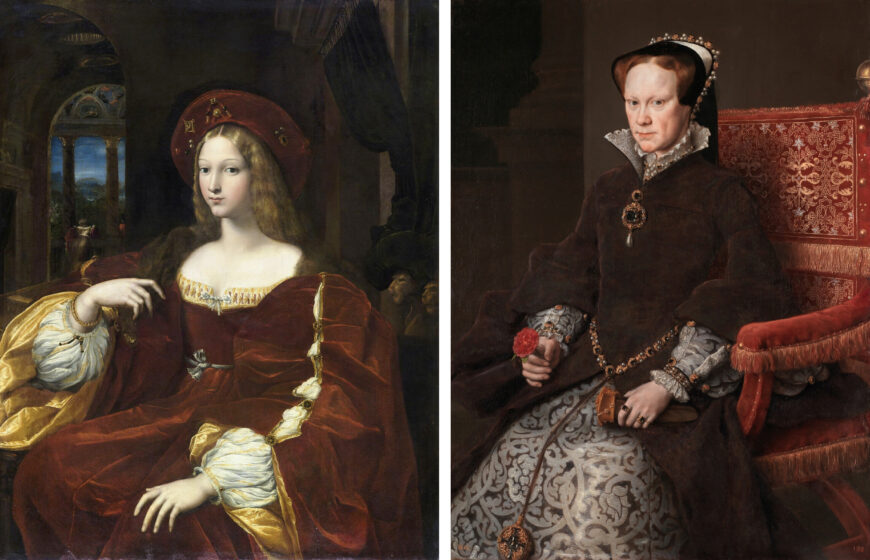
Left: Raphael and Giulio Romano, Doña Isabel de Requesens y Enríquez de Cardona-Anglesola, 1518, oil on canvas, 120 x 95 cm (Musée du Louvre, Paris); right: Anthonis Mor, Portrait of Mary Tudor, 1554, oil on panel, 178 x 136.5 cm (Museo Nacional del Prado, Madrid)
The royal, papal, and imperial connotations of the crimson velvet chair and the purple overgarment cannot have been lost on anyone who viewed the portrait. It is a portrait whose iconography seems to challenge the English Protestant legacy of Mary’s father, Henry VIII, and of her half-brother, Edward VI. However, although a Catholic, Mary was still a Tudor, and the rightful successor of her younger brother, Edward. This is the reason why her accession to the throne was greeted with wide popular support.
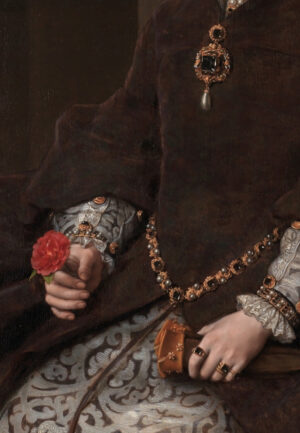
Rose, diamond ring, and pearl pendant (detail), Anthonis Mor, Portrait of Mary Tudor, 1554, oil on panel, 178 x 136.5 cm (Museo Nacional del Prado, Madrid)
The red rose
Mary is holding a red rose in her right hand. The rose is often a symbol of the Virgin Mary. It also signifies the Passion of Christ (his arrest, trial and suffering) and Christ’s sacrifice. The rose can also be read as a symbol of Mary’s dynastic heritage since it was the symbol of the House of Lancaster, to which Mary could trace her paternal line. [2]
A dynastic marriage
Mary wears a diamond ring on her left hand, and a diamond and pearl pendant hangs from her neck. The portrait thus speaks of another Catholic dynastic history: the very powerful Habsburgs. What is more, the column or pillar of authority in the left background (which can also be interpreted as a symbol of the Virgin Mary) suggests imperial dominion: Charles V’s impresa was a crowned eagle separated by twin columns, which represent the Pillars of Hercules.
The imminent marriage, and the fact that according to the Act of Marriage of 1554, Philip would rule jointly with Mary, caused a Protestant rebellion led by Sir Thomas Wyatt, which was successfully put down.
Mary’s marriage to Philip was not a match made in heaven. For the majority of her subjects, whose anti-papal and anti-Spanish hostilities had long been shaped by the policies of Henry VIII, she had married an enemy of the state. For Mary, it must have been a relatively joyless marriage, as Philip (who had mistresses) seems to have been less than enamored to have married a woman eleven years his senior. However, should Mary have produced an heir, preferably male, with Philip, it would have ensured a Catholic future for Tudor England and Ireland.
There is no disputing the fact that during Mary’s reign 237 men and 52 women, mostly of humble backgrounds, were burned at the stake for refusing to recant their “heretical” Protestant beliefs and swear allegiance to the Catholic faith. This earned Mary the infamous nickname “Bloody Mary” from later Protestant Tudor writers, and has tarnished Mary’s reputation ever since.
“It’s a man’s world”
If being reviled by Protestants for her Catholicism as “Bloody Mary” was not enough, Mary had to put up with being a woman in a man’s world. John Knox wrote the following anti-Catholic and rabidly misogynistic invective in The First Blast of the Trumpet Against the Monstrous Regiment of Women, which was a comment on Mary’s reign and was later universalized to apply to other female rulers, including Elizabeth I:
To promote a woman to bear rule, superiority, dominion, or empire above any realm, nation, or city is repugnant to nature, contumely to God, a thing most contrarious to his revealed will and approved ordinance, and, finally, it is the subversion of good order, of all equity and justice. John Knox, The First Blast of the Trumpet Against the Monstrous Regiment of Women, 1558
Mary’s funeral and memory
In a loyal act of royal sisterhood, at the funeral of Mary I on 14th December 1558, at Westminster Abbey, Mary’s heir, Elizabeth I, allowed the Catholic Bishop of Winchester, John White, to speak. He did so in explicitly gendered terms:
She was a King’s daughter, she was a King’s sister, she was a King’s wife. She was a Queen, and by the same title a King also: she [Elizabeth I] was a sister to her, that by the like title and right, is both King and Queen at this present of this realm.Bishop of Winchester, John White, 1558
The words of the Bishop of Winchester are a reminder that, despite her Catholicism, Mary I remained a member of the Tudor dynasty. Indeed, in her courage, in her impatience, and in her undoubted brutality, Mary was not so very different from her Tudor forebears, nor indeed her Tudor successor, Elizabeth I, whose reputation as “Gloriana” and “The Virgin Queen” has far outshone that of “Bloody Mary.” The two sisters were buried together in the north aisle of the Lady Chapel built by Henry VII in Westminster Abbey.
Anthonis Mor’s Portrait of Mary Tudor, arguably one of the finest and subtlest portraits produced in early modern Europe, is a historically significant painting that makes a complex statement about domestic and European dynastic politics and post-Reformation religious conviction.

